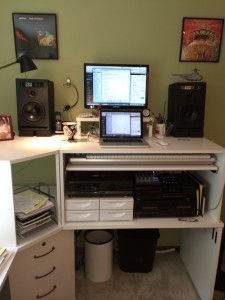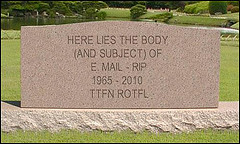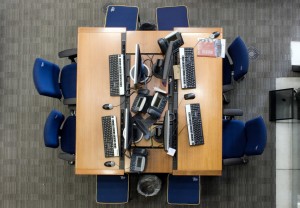 It is interesting to see the increasing trend toward cost-efficient “bullpen” work spaces. When I started my career as a just-graduated engineer at Boeing, I was seated at a military-issue olive-green desk with a black phone, in the middle of a sea of identical desks with identical black phones. The only offices were window-less boxes for the managers along the four seemingly-endless walls of our “pen.”
It is interesting to see the increasing trend toward cost-efficient “bullpen” work spaces. When I started my career as a just-graduated engineer at Boeing, I was seated at a military-issue olive-green desk with a black phone, in the middle of a sea of identical desks with identical black phones. The only offices were window-less boxes for the managers along the four seemingly-endless walls of our “pen.”
No doubt it was incredibly cost-effective, but you could not have designed a more efficient environment for killing creativity and productivity if you had tried – except by perhaps introducing a marching band to the mix. Surrounded on all sides by ringing phones, conversations, and constantly being interrupted by one of your within-arms-reach neighbors made focus and any kind of mental continuity all but impossible.
Unleash Your Team’s Talent
Contrast that with my next career stop – a large defense/aerospace company in Texas. This was a dramatically different environment. Nearly everyone had an office. New engineers shared offices with one or two other team members, but that system worked pretty well as the newbies usually had lots of questions and could pool their knowledge with their office mates.
The work was intense and required a tremendous amount of focus, creativity and problem solving – activities that wither and die in an environment of constant noise, conversation and interruptions. Providing offices was undoubtedly a more expensive option, but essential to unleashing the talent of the team.
In-Your-Face Time
Aside from cost-efficiencies, other justifications for “open-office” floor plans include facilitating communications (is that really necessary in this hyper-connected day and age?), and discouraging unproductive time wasting (web-surfing, personal calls, etc).
Of course communications are extremely important, in fact communication habits are perhaps the most powerful differentiators between high-performing teams and those that are not. Short, purposeful face-to-face communications top the list of performance boosters, but that kind of face-time is very different from having someone in your face all the time! The latter is a focus, concentration, and creativity killer.
With regard to discouraging unproductive behavior; If your employees activities are being managed instead of their results, and they can’t be trusted to do the right thing when out from under someone’s watchful eye, you are fighting an unwinnable battle. An open floor plan won’t solve that problem.
Protect Your Investment
With all we now know about how our brains work, the creative process and productivity, it is mind-boggling to me that the trend is apparently moving back to the bullpen model. It goes against everything we’ve learned about maximizing mental output. Brainstorming groups are a great example. Current research shows that individuals working in solitude outperform brainstorming groups in both the number of ideas generated and the originality and uniqueness of the ideas. We need to be able to focus to do our best work.
Bullpen environments minimize something else besides costs, creativity, and productivity: retention. Being constantly under the microscope without any privacy is unpleasant, stressful, and imparts a lack of trust. That can cost you valuable talent, and replacing employees is extremely expensive.
For most businesses, payroll is by far the greatest expense. Maximize the investment in your people by creating an environment, culture and mindset that energizes and engages people, and boosts their ability to be creative and productive. You’ll find that it will give you a competitive advantage that will pay dividends for years to come.
[Photo courtesy of David Sim]





